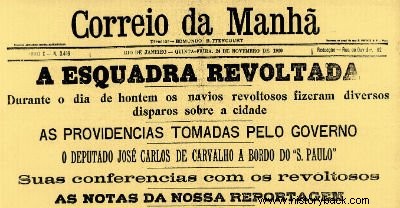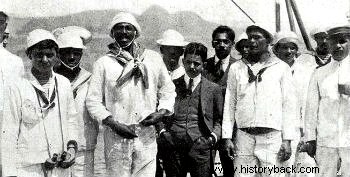The Revolt of the Whip was a military agitation in the Brazilian Navy, which took place in Rio de Janeiro, from November 22 to 27, 1910.
The fight against physical punishment, low wages and terrible working conditions are the main causes of the revolt.
Historical Context
At the time, it is worth noting that in the Brazilian Navy, sailors were mainly recently freed black slaves. These were subjected to an arduous work routine in exchange for low wages.
Any dissatisfaction was punishable and discipline on the ships was maintained by the officers through physical punishment, of which the “whip” was the most common punishment.
Despite having been abolished in most of the world's armed forces, physical punishment was still a reality in Brazil.
The sailors' dissatisfaction grew after the officers received salary increases, but not the sailors.

First page of Correio da Manhã newspaper, on November 24, 1910.
In addition, the new and modern battleships that the Brazilian government had ordered, the "Minas Gerais" and "São Paulo", required an even greater number of men to operate, overloading the sailors. These two warships were the most powerful and modern in the Brazilian fleet.
So, with the increase in officers' salaries and the creation of a new table of services that did not reach the lower ranks, some sailors began to plan a protest.
The Uprising
At dawn on November 22, 1910, the sailors of the battleship "Minas Gerais" rebelled.
The trigger came after watching the punishment of the sailor Marcelino Rodrigues Menezes, flogged until he fainted with 250 lashes (the normal was 25) for assaulting an officer.
The uprising was led by the experienced João Cândido Felisberto, black and illiterate sailor. The mutiny ended with the death of the ship's commander and two other officers, who refused to abandon the warship.
That same night, the battleship "São Paulo" joined the mutiny. In the following days, other vessels joined the movement, such as the "Deodoro" and "Bahia", large warships.
In turn, in Rio de Janeiro, President Hermes da Fonseca had just taken office and was facing his first crisis. Rebel ships bombed the city of Rio de Janeiro to demonstrate that they were not hiding.
In a letter to the government, the rebels requested:
- the end of corporal punishment;
- better food and working conditions;
- amnesty for all involved in the uprising.
Thus, on November 26, President Marechal Hermes da Fonseca accepted the demands of the mutineers, ending that episode of the revolt.
However, two days after handing over the weapons, a “state of siege” was decreed, initiating the purge and imprisonment of those sailors considered undisciplined.
End of Revolt

João Cândido, third from left, on the third day of the revolt.
The sailors were arrested at Ilha das Cobras headquarters of the Naval Battalion. Feeling betrayed, the sailors mutinied on December 9, 1910.
The government's response was harsh and the prison was bombed and destroyed by the army, killing hundreds of marines and prisoners.
The mutineers, totaling 37 people, were taken to two solitary prisons, where they suffocated to death. Only João Cândido and another fighting companion survived.
As a result, in 1911, those who joined the movement had already been killed, imprisoned or expelled from military service. Many of those involved were sent to forced labor camps in the rubber plantations of the Amazon and in the construction of the Madeira-Mamoré railway.
As a result, the conflict left more than two hundred dead and wounded among the mutineers, of which about two thousand were expelled after the revolt. In the legalist portion, about twelve people died, including officers and sailors.
As for the leader, João Cândido, after surviving prison and being exonerated, he was considered unbalanced and admitted to a hospice. For his audacity, the press at the time called him the Black Admiral.
He would be acquitted of conspiracy charges on December 1, 1912, but was expelled from the Navy.
He survived as a fisherman and salesman until journalist Edmar Morel rescued his story from oblivion and released the book "The Revolt of the Lash ", in 1959.
Only on July 23, 2008, the Brazilian government understood that the causes of the revolt were legitimate and granted amnesty to the sailors involved.
Curiosities
- The Revolt of the Whip was inspired by the mutiny of the sailors of the Russian Imperial Navy, carried out on the battleship Potemkin, in 1905.
- The song "The Master of the Seas ", composed by João Bosco and Aldir Blanc, in 1975, was made in honor of the leader of the Revolta da Chibata. The lyrics were censored by the military regime.
- Currently, there is a statue of João Cândido in Praça XV, in Rio de Janeiro, placed there in 2008.
Read more :
first republic
Treaty of Petrópolis
